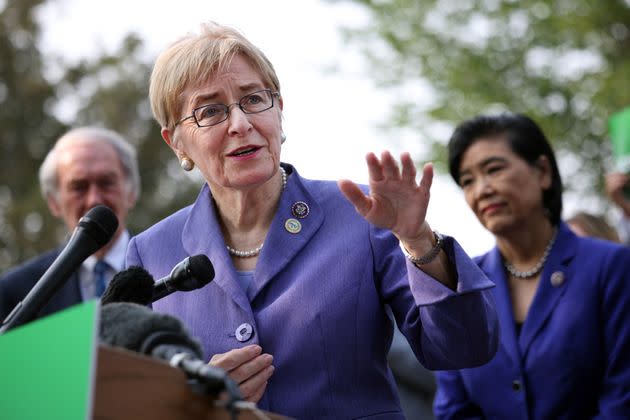The GOP Is Trying To Erase The Longest-Serving Woman In Congress
- Oops!Something went wrong.Please try again later.

The longest-serving woman currently in Congress, a Democrat from a manufacturing district in the Midwest, could lose her seat in a GOP-led redistricting effort if the party’s current proposals go unchallenged.
Rep. Marcy Kaptur, a Democrat from Toledo, Ohio, who will begin her 39th year in office this January, would see a significant hurdle to her next reelection. Dueling maps from both GOP-dominated state legislative chambers create a virtually unwinnable district for Kaptur, 75.
“It’s a very unusual drawing of congressional districts,” Kaptur said of the maps in general, which might leave Democrats with as few as two or three congressional districts in a battleground state soon to have 15 House seats. “They don’t hang together. It almost looks like they want to dilute the power of metropolitan areas.”
It’s not certain that Republicans, who argue Ohio’s partisan makeup is no longer the competitive split that Democrats make it out to be, will even pass the proposed maps unchanged.
“It’s pretty clear neither one of these maps are going to fly,” Ohio Gov. Mike DeWine, a Republican, said this week.
To some Republicans, the maps are just a launch point. But Democrats see them as another extreme gerrymander they’re likely to challenge in court.
Kaptur isn’t the only looming Democratic casualty in Ohio. Republicans are looking to eliminate the seat held by Rep. Tim Ryan, who’s running for Senate in 2022. Both chambers’ maps stick a downtown Columbus condo owned by Rep. Joyce Beatty, chair of the Congressional Black Caucus, in GOP districts — one in Rep. Jim Jordan’s central Ohio district and another in newly elected Rep. Mike Carey’s.
In nearly a dozen states, Democrats have backed the creation of independent redistricting commissions aimed at drawing fairer congressional and state legislative boundaries, following rampant GOP gerrymandering a decade ago. But Republicans still have the upper hand in key state legislatures across the country.
That includes Ohio, where voters passed reforms in 2015 and 2018 that theoretically offered Democrats more power in exchange for not having to revisit map-drawing before the next 10-year census. The clock ran out on that potential avenue for bipartisanship, however, when the state’s redistricting commission blew past its deadline last month, punting the job to legislators.
Kaptur’s current district is often cited as an example of extreme partisan gerrymandering. Drawn to pick up Democratic communities along the Lake Erie shore, the district extends in a skinny line from Toledo to Cleveland, chopping up counties over more than a 100-mile stretch. It’s sometimes mockingly called the “Snake on the Lake.”
Maps floated in Ohio’s House and Senate would give Kaptur some deep red counties that helped propel Donald Trump’s 2016 and 2020 victories in Ohio ― a state that used to be considered a bellwether for presidential elections before Trump’s commanding wins there. Ohio’s 9th Congressional District would still be anchored in Kaptur’s blue hometown, known for glassmaking and auto manufacturing, though the proposals on the table would change the boundaries of her district to give the GOP anywhere from a 6% to 20% advantage.
Asked whether she would prefer her existing district or the redraw that GOP lawmakers are proposing, Kaptur scoffed.
“Well, I don’t like either one,” she said. “The districts do not represent communities of interest.”
The longtime Democrat is no stranger to challenging elections. After the last round of redistricting, Kaptur was drawn into a district with another Democratic incumbent, Cleveland Rep. Dennis Kucinich. She beat him by 16 percentage points in the 2012 primary and went on to romp Republican Samuel “Joe the Plumber” Wurzelbacher in the general election.
In 2018, Kaptur became the longest-serving woman in House history, beating the record held by Rep. Edith Nourse Rogers (D-Mass.), who died in 1960. She’s on track to surpass former Sen. Barbara Mikulski (D-Md.), who served in both chambers, as the longest-serving woman in congressional history with 40 years in office.
Kaptur is perhaps best known for sponsoring the legislation that created the National World War II Memorial, and for declining to join the 1996 Reform Party ticket with Ross Perot as his vice presidential running mate. She’s also a fierce opponent of trade deals, voting against the North American Free Trade Agreement and its Trump-era replacement, the United States-Mexico-Canada Agreement.
Even with a challenging reelection effort on the horizon, Kaptur said she doesn’t have plans to retire just yet.
“We will compete where the lines are, and we will represent Ohioans and their best interests,” she said.
This article originally appeared on HuffPost and has been updated.



